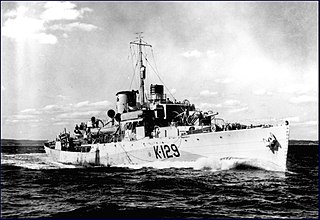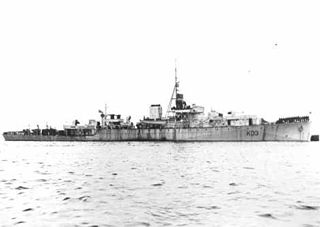
HMCS Agassiz was a Flower-class corvette of the Royal Canadian Navy. Named after the community of Agassiz, British Columbia, the ship was constructed by Burrard Dry Dock Co. Ltd. in North Vancouver, British Columbia and was launched on 15 August 1940. The corvette was commissioned on 23 January 1941 in Vancouver, British Columbia. The Flower class were initially designed for coastal service during the Second World War, but due to the demands of the Battle of the Atlantic, Agassiz was used primarily as an ocean escort for convoys crossing the Atlantic Ocean in engagements with German submarines. Following the war, the corvette was sold for scrap.

HMCS Eyebright was a Flower-class corvette that served mainly with the Royal Canadian Navy during the Second World War in the Battle of the Atlantic. She was named after the medicinal flowering plant genus Euphrasia.

HMCS Amherst was a Flower-class corvette of the Royal Canadian Navy. She served primarily in the Battle of the Atlantic on convoy protection duty during the Second World War. She was named for Amherst, Nova Scotia. The ship was laid down at Saint John Dry Dock and Shipbuilding Co. Ltd. in Saint John, New Brunswick, on 23 May 1940 and launched on 3 December later that year. Amherst was commissioned on 5 August 1941 and served in the Battle of the Atlantic and Battle of the St. Lawrence, earning battle honours for both actions. After the war, the ship was decommissioned and sold to Venezuelan Navy in 1945 and renamed Carabobo. However, while en route to Venezuela, the ship was wrecked in the Gulf of St. Lawrence that same year.

HMCS Algoma was a Flower-class corvette that served with the Royal Canadian Navy in the Second World War. Named for the Algoma District of Ontario, it served primarily in the Battle of the Atlantic. After the war it was sold to the Venezuelan Navy and renamed Constitución.
HMCS Clayoquot was a Bangor-class minesweeper that served with the Royal Canadian Navy during the Second World War. She saw action mainly in the Battle of the Atlantic. She was sunk in 1944. The minesweeper was named after Clayoquot Sound on Vancouver Island, British Columbia.

HMCS Fennel was a Flower-class corvette that served primarily with the Royal Canadian Navy during the Second World War. Originally commissioned into the Royal Navy, she served as an ocean escort in the Battle of the Atlantic.

HMCS Owen Sound was a modified Flower-class corvette that served with the Royal Canadian Navy during the Second World War. She fought primarily in the Battle of the Atlantic as a convoy escort. She was named for Owen Sound, Ontario.

HMCS Capilano was a River-class frigate that served with the Royal Canadian Navy during the Second World War. She served primarily as a convoy escort in the Battle of the Atlantic. She is named for Capilino River in North Vancouver, British Columbia. The navy intended to name the ship after North Vancouver, however due to possible confusion with HMCS Vancouver, she was named after the lake.

HMCS St. Catharines was a River-class frigate that served with the Royal Canadian Navy during the Second World War. She served primarily as a convoy escort in the Battle of the Atlantic. She was named for St. Catharines, Ontario. After the war she was re-purposed as a weather ship for use by the Department of Transport of Canada.

HMCS Dunver was a River-class frigate that served with the Royal Canadian Navy during the Second World War. She served primarily as a convoy escort in the Battle of the Atlantic. She was named for Verdun, Quebec. Her name was altered to prevent confusion with other Allied warships named Verdun.

HMCS Wentworth was a River-class frigate that served with the Royal Canadian Navy during the Second World War. She served primarily as a convoy escort in the Battle of the Atlantic. She was named in honour of the town of Dartmouth, Nova Scotia. She could not be named HMCS Dartmouth for fear of confusion with HMS Dartmouth, and so was named after a famous early resident, Nova Scotia Lieutenant Governor Sir John Wentworth. Her name is often mistakenly associated with Wentworth County, Ontario, in honour of the city of Hamilton.

HMS Annan was a River-class frigate built for the Royal Navy but was transferred to the Royal Canadian Navy before commissioning. She served with the Royal Canadian Navy during the Second World War and saw action primarily as a convoy escort in the Battle of the Atlantic. She was returned to United Kingdom following the war and quickly sold to Denmark, who renamed the vessel Niels Ebbesen. She was primarily used as a training vessel until 1963 when she was broken up in Odense. She was named for the River Annan in Scotland in UK and Canadian service and Niels Ebbesen in Danish service.
HMS Meon was a River-class frigate that served with the Royal Navy and Royal Canadian Navy in the Second World War. The vessel was used primarily as a convoy escort in the Battle of the Atlantic, but also took part in the Invasion of Normandy. After the war, the ship was converted to a headquarters vessel for amphibious operations, and saw service in the Persian Gulf from 1952 to 1965, before being scrapped in 1966. She was named for the River Meon in the United Kingdom and was sponsored by the town of Bletchley in Buckinghamshire.

HMCS Waskesiu was a River-class frigate of the Royal Canadian Navy. The frigate served as a convoy escort in the Battle of the Atlantic during the Second World War. It was the first frigate constructed and commissioned into the Royal Canadian Navy. Following the war, the vessel was sold to India where it was renamed Hooghly. Named after the town of Prince Albert, Saskatchewan, there was already a warship named "Prince Albert". The Royal Canadian Navy then named the ship after the town closest to Prince Albert National Park.

HMS Monnow was a River-class frigate of the Royal Navy. The frigate served as a convoy escort in the Battle of the Atlantic during the Second World War. Named for the River Monnow in the United Kingdom, the vessel was transferred to the Royal Canadian Navy in 1944, keeping the same name, and finished the war with them. Returned to the Royal Navy following the war, it was sold to the Royal Danish Navy and renamed Holger Danske. It served until 1960 when it was scrapped. The ship is significant as it is one of the few ships employed by the Royal Canadian Navy never to visit Canada.
HMCS Transcona was a Bangor-class minesweeper built for the Royal Canadian Navy during the Second World War. She was launched on 26 April 1941. After the war, she was transferred to the Royal Canadian Mounted Police under the name French. The vessel served until 1961 before being sold for scrap and broken up later that year.
HMCS Gananoque was a Bangor-class minesweeper constructed for the Royal Canadian Navy during the Second World War. Named for the town of Gananoque, Ontario situated on the Saint Lawrence River, the minesweeper entered service in 1941 and participated in the Battle of the Atlantic and the Battle of the Saint Lawrence, mainly as a convoy escort. Following the end of the war in 1945 Gananoque was decommissioned and placed in reserve. The vessel was reacquired in 1952, but never reentered service and was sold for scrap in 1959 and broken up.
HMCS Georgian was a Bangor-class minesweeper constructed for the Royal Canadian Navy during the Second World War. Primarily used as a convoy escort in the Battle of the Atlantic and the Battle of the St. Lawrence, the minesweeper had the misfortune of mistakenly sinking the British submarine HMS P514 off the coast of Newfoundland. Georgian also saw service in European waters, taking part in the invasion of Normandy. Following the war the ship was discarded and sold for scrap.
HMCS Mahone was a Bangor-class minesweeper constructed for the Royal Canadian Navy during the Second World War. Entering service in 1941, the ship took part in the Battle of the Atlantic and the Battle of the Saint Lawrence as a convoy escort. Following the war, the minesweeper was decommissioned and placed in reserve. Reacquired during the Korean War, Mahone was never recommissioned into the Royal Canadian Navy and was instead sold to the Turkish Navy in 1958. Renamed Beylerbeyi, the minesweeper remained in service until 1972 when she was discarded.
HMCS Fort William was a Bangor-class minesweeper that served with the Royal Canadian Navy during the Second World War. Entering service in 1942, the minesweeper participated in the Battle of the Atlantic as a convoy escort and in the invasion of Normandy. Following the war, the ship was laid up, but was reacquired during the Korean War. Fort William never re-entered service with the Royal Canadian Navy and in 1957, was sold to Turkey. Renamed Bodrum by the Turkish Navy, the ship was discarded in 1971.













